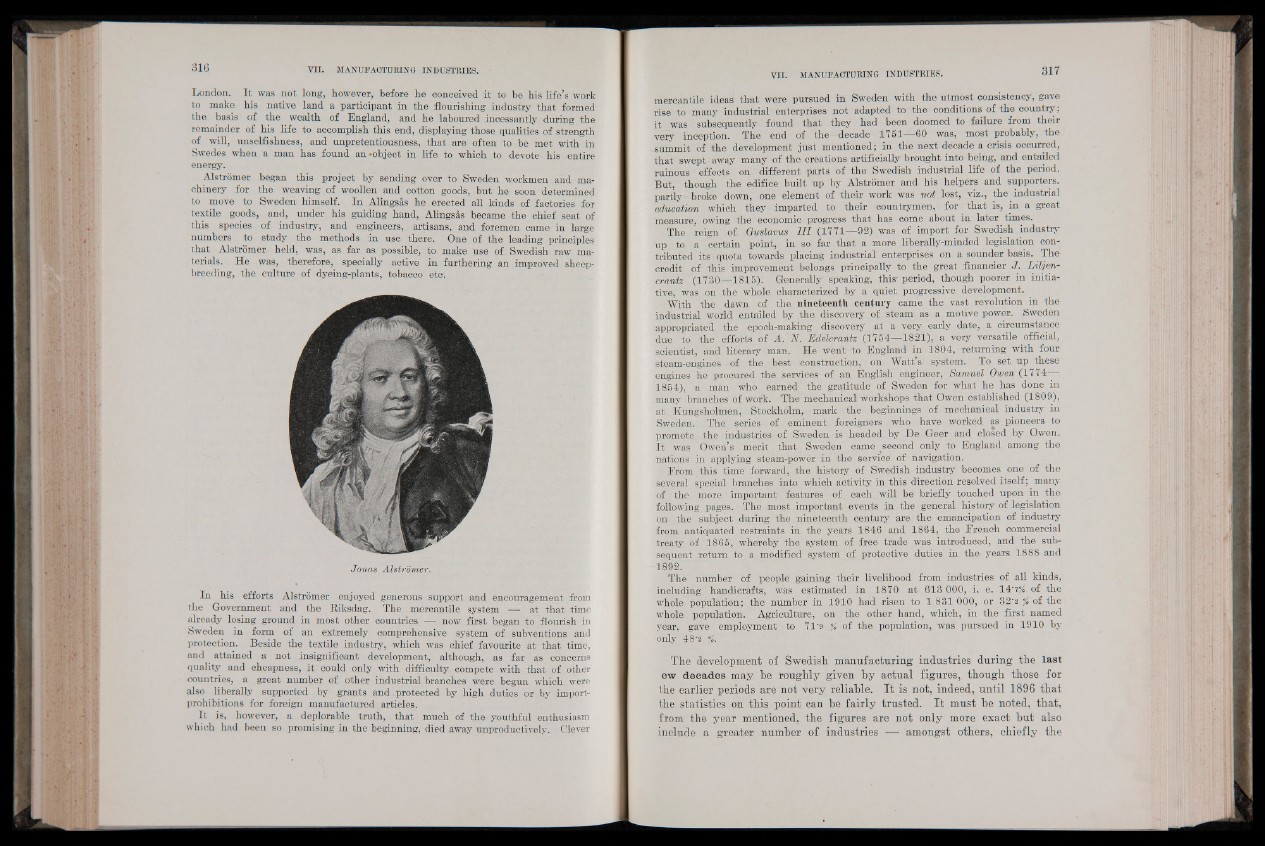
London. It was not long, however, before he conceived it to' be his life’s work
to make his native land a participant in the flourishing industry that formed
the basis of the wealth of England, and he laboured incessantly during the
remainder of his life to accomplish this end, displaying those qualities of strength
of will, unselfishness, and unpretentiousness, that are often to be met with in
Swedes when a man has found an-object in life to which to devote, his entire
energy.
Alstromer began this project by sending over to Sweden workmen and machinery
for the weaving of woollen and cotton goods, but he soon determined
to move to Sweden himself. In Alingsas he erected all kinds of factories for
textile goods, and, under his guiding hand, Alingsas became the chief seat of
this species of industry, and engineers, artisans, and foremen came in large
numbers to study the methods in use there. One of the leading principles
that Alstromer held, was, as far as possible, to make use of Swedish raw materials.
He was, therefore, specially active in furthering an improved sheep-
breeding, the culture of dyeing-plants, tobacco etc.
Jonas Alstromer.
In his efforts Alstromer enjoyed generous support and encouragement from
the Government and the Riksdag. The mercantile system — at that time
already losing ground in most other countries — now first began to flourish in
Sweden in form of an extremely comprehensive system of subventions and
protection. Beside the textile industry, which was chief favourite at that time,
and attained a not insignificant* development, although, as far as concerns
quality and cheapness, i t ‘could only with difficulty compete with that of other
countries, a great number of other industrial branches were begun which were
also liberally supported by grants and protected by high duties or by import-
prohibitions for foreign manufactured articles.
It is, however, a deplorable truth, that much of the youthful enthusiasm
which had been so promising in the beginning, died away unproductively. Clever
mercantile ideas that were pursued in Sweden with the utmost consistency, gave
rise to many industrial enterprises not adapted to the conditions of the country;
it was subsequently found that they had been doomed to failure from their
very inception. The end of the-decade 1751— 60 was, most probably, the
summit of the development just mentioned; in the next decade a crisis occurred,
that swept away many of the creations artificially brought into being, and entailed
ruinous effects on different parts of the Swedish industrial life of the period.
But, though the edifice built up by Alstromer and his helpers and supporters,
partly broke down, one element of their work was not lost, viz., the industrial
education which they imparted to their countrymen, fo r , that is, in a great
measure, owing the economic progress that has come about in later times.
The reign of Gustavus III (1771— 92) was of import for Swedish industry
up to a certain point, in so far that a more liberally-minded legislation contributed
its quota towards placing industrial enterprises on a sounder basis. The-
credit of this improvement belongs principally to the great financier J. Liljen-
crantz (1730—1815). Generally speaking, this' period, though poorer in initiative,
was on the whole characterized by a quiet progressive development.
■ With the dawn of the nineteenth century came the vast revolution in the
industrial world entailed by the discovery‘of steam as a motive power. Sweden
appropriated the epoch-making discovery at a very early date, a circumstance
due to the efforts of A. N. Edelcrantz (1754—1821), a very versatile official,
scientist, and literary man.. He went to England in 1804, returning with four
steam-engines -o f the b e st1 construction, ■ Bn Watt’s system. To set up these
engines he procured the services of an English engineer, Samuel Owen (1774—
1854), a man who earned the gratitude of Sweden for what he has done in
many branches of work. The mechanical workshops that Owen established (1809),
at Kungsholmen, Stockholm, mark the beginnings of mechanical industry in
Sweden. The series o f . eminent. foreigners who have worked as pioneers to
promote the industries of Sweden is headed by De Geer and closed by Owen.
It was Owen’s merit that Sweden came ^econd only to England among the
nations in applying steam-power in the service of navigation.
From - this time forward, the history of Swedish industry becomes one of the
several special branches into which activity in this direction resolved itself; many
of the more important features of each will be briefly touched upon in the
following pages. The most important events in the general history of legislation
on the subject during the nineteenth century are the emancipation of industry
from antiquated restraints in the years 1846 and 1864, the French commercial
treaty of 1865, whereby the system of free trade was introduced, and the subsequent
return to a modified system of protective duties in the years 1888 and
1892.
The number of people, gaining their livelihood from industries of all kinds,
including handicrafts, was estimated in 1870 at 613 000, i. e. 14*7^ of the
whole population; the number in 1910 had risen to 1 831 000, or 32"2 % of the
whole population. Agriculture, on the other hand, which, in the first named
year, gave employment to 71'» % of the population, was pursued in 1910 by
only 48 ‘2 %.
The development of Swedish, manufacturing industries during the last
ew decades may be roughly given by actual figures, though those for
the earlier periods are not very reliable. It is not, indeed, until 1896 that
the statistics on this point can be fairly trusted. It must be noted, that,
from the year mentioned, the figures are not only more exact but also
include a greater number of industries ^ifamongst others, chiefly the